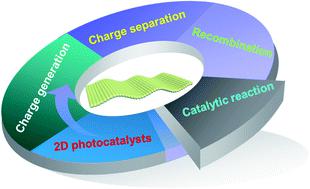当前位置:
X-MOL 学术
›
J. Mater. Chem. A
›
论文详情
Our official English website, www.x-mol.net, welcomes your
feedback! (Note: you will need to create a separate account there.)
Charge steering in ultrathin 2D nanomaterials for photocatalysis
Journal of Materials Chemistry A ( IF 10.7 ) Pub Date : 2020-06-17 , DOI: 10.1039/d0ta04923a Jun Xiong 1, 2, 3, 4 , Jun Di 5, 6, 7, 8 , Huaming Li 1, 2, 3, 4
Journal of Materials Chemistry A ( IF 10.7 ) Pub Date : 2020-06-17 , DOI: 10.1039/d0ta04923a Jun Xiong 1, 2, 3, 4 , Jun Di 5, 6, 7, 8 , Huaming Li 1, 2, 3, 4
Affiliation

|
During the photocatalytic reaction, charge carriers play a dominant role in affecting the entire catalytic processes. Accordingly, recent endeavours on charge steering in ultrathin 2D photocatalysts to achieve high photocatalytic efficiency from the aspects of increasing charge generation, boosting charge transport and separation, suppressing charge recombination, and accelerating reaction kinetics are reviewed. Diverse strategies for effective tuning based on ultrathin 2D photocatalysts have been thoroughly discussed. Specifically, for charge generation, disorder engineering, doping, and plasmonic engineering can be effective approaches for extending the absorption range, while thickness control, crystal phase engineering, and molecular incorporation can increase the absorption intensity. For charge transport and separation, tuning the morphology, electrical conductivity, internal electric field and polarization is demonstrated to be able to boost bulk charge separation. Strategies like surface defect engineering, surface modification, incorporation of water-soluble molecular co-catalysts and shortening the surface migration distance are employed for boosting surface charge separation. Subsequently, strategies like constructing 2D/2D heterostructures, Z-scheme systems, in-plane heterojunctions and Moiré superlattices are presented to suppress charge recombination. Finally, surface polarization, co-catalyst modification, single atom engineering, crystal facet engineering, and vacancy engineering are summarized to accelerate reaction kinetics. Moreover, concluding remarks and perspectives on the future exploration of charge manipulation in ultrathin 2D photocatalysts are presented.
中文翻译:

超薄2D纳米材料中的电荷控制用于光催化
在光催化反应过程中,载流子在影响整个催化过程中起主要作用。因此,从增加电荷产生,促进电荷输送和分离,抑制电荷复合以及加速反应动力学等方面综述了近年来在超薄2D光催化剂中电荷控制以实现高光催化效率的努力。已经充分讨论了基于超薄2D光催化剂进行有效调节的各种策略。具体地,对于电荷产生,无序工程,掺杂和等离子体工程可以是扩展吸收范围的有效方法,而厚度控制,晶相工程和分子掺入可以增加吸收强度。为了进行电荷传输和分离,调整形态,电导率,内部电场和极化被证明能够促进大电荷分离。采用诸如表面缺陷工程,表面改性,掺入水溶性分子助催化剂以及缩短表面迁移距离等策略来促进表面电荷分离。随后,提出了诸如构造2D / 2D异质结构,Z方案系统,面内异质结和莫尔超晶格之类的策略来抑制电荷复合。最后,总结了表面极化,助催化剂改性,单原子工程,晶体面工程和空位工程,以加快反应动力学。此外,还提供了有关超薄2D光催化剂中电荷操纵的未来探索的结论和观点。
更新日期:2020-07-07
中文翻译:

超薄2D纳米材料中的电荷控制用于光催化
在光催化反应过程中,载流子在影响整个催化过程中起主要作用。因此,从增加电荷产生,促进电荷输送和分离,抑制电荷复合以及加速反应动力学等方面综述了近年来在超薄2D光催化剂中电荷控制以实现高光催化效率的努力。已经充分讨论了基于超薄2D光催化剂进行有效调节的各种策略。具体地,对于电荷产生,无序工程,掺杂和等离子体工程可以是扩展吸收范围的有效方法,而厚度控制,晶相工程和分子掺入可以增加吸收强度。为了进行电荷传输和分离,调整形态,电导率,内部电场和极化被证明能够促进大电荷分离。采用诸如表面缺陷工程,表面改性,掺入水溶性分子助催化剂以及缩短表面迁移距离等策略来促进表面电荷分离。随后,提出了诸如构造2D / 2D异质结构,Z方案系统,面内异质结和莫尔超晶格之类的策略来抑制电荷复合。最后,总结了表面极化,助催化剂改性,单原子工程,晶体面工程和空位工程,以加快反应动力学。此外,还提供了有关超薄2D光催化剂中电荷操纵的未来探索的结论和观点。











































 京公网安备 11010802027423号
京公网安备 11010802027423号